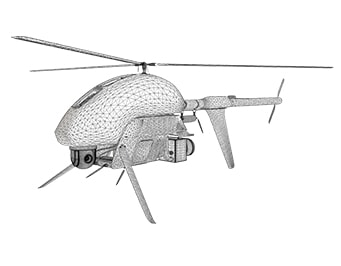Educational Material
2.2 Datums & World Models
Like reference frames, datums and world models provide needed references for navigation. A datum is a reference used for taking a measurement and is used in many applications including navigation and land surveying as well as for drafting purposes such as geometric dimensioning and tolerancing. World models provide references for the gravitational and magnetic fields that can be used across multiple science and engineering disciplines, including navigation.
Gravity & Altitude
Various models and datums are used to describe the shape of the earth and its gravitational potential field. These not only define the value of gravity used in navigation equations, but define the measure of altitude. The WGS84 model described below defines altitude relative to a simple ellipsoid model of the earth, whereas the EGM96 model can be used to define altitude relative to Mean Sea Level (MSL), which is an equipotential surface of the EGM96 gravitational model. The altitude measured relative to MSL can be as much as 100 meteroff from the altitude measured relative to WGS84.
World Geodetic System 1984 (WGS84)
The World Geodetic System of 1984 (WGS84) is a global datum and standard, whose definition of the ellipsoid shape of the earth is widely used in many different fields, including navigation. The size and shape of the earth described by WGS84 defines the transformation between cartesian ECEF coordinates and latitude-longitude-altitude (LLA) coordinates. Since GPS uses it for reporting LLA, its use is ubiquitous in navigation.
Earth Gravitational Model 1996 (EGM96)
The Earth Gravitational Model of 1996 (EGM96) is a world model and reference frame used as a gravity model of the earth. The model uses spherical harmonics to define Earth's gravitational potential complete to degree and order of 360. In addition to providing the value of $g$, this model defines the geoid: the shape that the surface of the oceans would take under the influence of Earth's gravity and rotation alone. The geoid is an equipotential surface which by definition means that every point in a specific region of space is at the same gravitational potential. Such an equipotential surface is used to define Mean Sea Level.
Magnetic Field Models
Earth's magnetic field varies drastically across the planet. While a simple dipole model provides a reasonable first order approximation, more detailed models are required to achieve heading accuracy in single-digit degrees. These models provide the magnetic field as a 3D vector in the ECEF frame for every point on Earth, from which can be calculated the declination angle (offset between Magnetic North and True North), and the inclination angle (offset of total field vector from horizontal).
World Magnetic Model (WMM)
The World Magnetic Model (WMM) is a spherical harmonics based model of Earth's magnetic field and provides the declination angle, which is the difference between Magnetic North and True North, for a specific location. It is the standard model for navigation systems, such as an attitude and heading reference systems (AHRS), and is used by many government and international agencies including the U.S. Department of Defense, the U.K. Ministry of Defense, NATO, and the International Hydrographic Organization (IHO). The WMM is a predictive model as Earth's magnetic field changes over time. Due to this, the WMM is updated every five years to represent any changes in the magnetic field that may occur.
International Geomagnetic Reference Field (IGRF)
The International Geomagnetic Reference Field (IGRF) is a backward-looking, corrected magnetic model of Earth that combines parameters of the World Magnetic Model with measured magnetic field data from surveys, observatories, and satellites around the world. This model is used largely by the scientific community and has similar accuracy to that of the World Magnetic Model.
